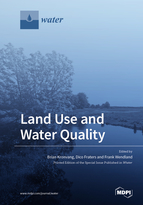Land Use and Water Quality
A special issue of Water (ISSN 2073-4441).
Deadline for manuscript submissions: closed (15 May 2020) | Viewed by 59818
Special Issue Editors
Interests: catchment science and management; water quality in surface waters; river and wetland restoration; functioning of riparian buffers
Interests: modeling groundwater recharge through rainfall
Special Issues, Collections and Topics in MDPI journals
Special Issue Information
Dear Colleagues,
Agriculture provides food, fibre, energy, and, last but not least, a living for many people around the world. One potential drawback of agricultural production is pollution of the aquatic environment by nutrients, pesticides, and trace elements. Growth in agricultural production, as has occurred in Europe and North America since the 1950s and more recently in many other parts of the world, threatens the quality of groundwater and surface waters or has already led to deterioration of the quality of these waters. Typical hotspot areas with problems can be found in Denmark, the Netherlands, northern Italy, Germany, France, China, the United States, and New Zealand.
Policies to abate the deterioration of water quality have been developed and programmes to improve water quality have been implemented. For example, the European Union has adopted directives (the Nitrates Directive in 1991; the Water Framework Directive in 2000; and the Groundwater Directive in 2006) that should result in all waters having good quality by 2027. Experiences from the last 15 to 25 years make clear that it will be a great challenge to realise these objectives in the remaining years of this decade. Nevertheless, it is has become clear that realisation of the objectives of these policies has become more difficult, not only because the easy, low cost measures have already been implemented, but also because there is a pressure to increase agricultural production. Is the twin aim of increasing agricultural production and at the same time improving water quality a realistic one? Which measures are most effective for water quality improvement and at the same time the most cost-effective? Should measures be enforced by law or implemented on a voluntary basis? These are some of the issues that should be addressed in this Special Issue from the Land Use and Water Quality (LUWQ) conference series, of which LUWQ2019 was held at Aarhus University from 3 to 6 June 2019.
Prof. Dr. Brian Kronvang
Dr. Dico Dico Fraters
Prof. Dr. Frank Wendland
Guest Editors
Manuscript Submission Information
Manuscripts should be submitted online at www.mdpi.com by registering and logging in to this website. Once you are registered, click here to go to the submission form. Manuscripts can be submitted until the deadline. All submissions that pass pre-check are peer-reviewed. Accepted papers will be published continuously in the journal (as soon as accepted) and will be listed together on the special issue website. Research articles, review articles as well as short communications are invited. For planned papers, a title and short abstract (about 100 words) can be sent to the Editorial Office for announcement on this website.
Submitted manuscripts should not have been published previously, nor be under consideration for publication elsewhere (except conference proceedings papers). All manuscripts are thoroughly refereed through a single-blind peer-review process. A guide for authors and other relevant information for submission of manuscripts is available on the Instructions for Authors page. Water is an international peer-reviewed open access semimonthly journal published by MDPI.
Please visit the Instructions for Authors page before submitting a manuscript. The Article Processing Charge (APC) for publication in this open access journal is 2600 CHF (Swiss Francs). Submitted papers should be well formatted and use good English. Authors may use MDPI's English editing service prior to publication or during author revisions.
Keywords
- Land Use and Water Quality
- Groundwater Surface Waters
- Water Quality Management
- Water Quality Monitoring
- Water Quality Modelling
- Implementation of Measures for Water Quality
- Assessment of Policies for Water Quality







